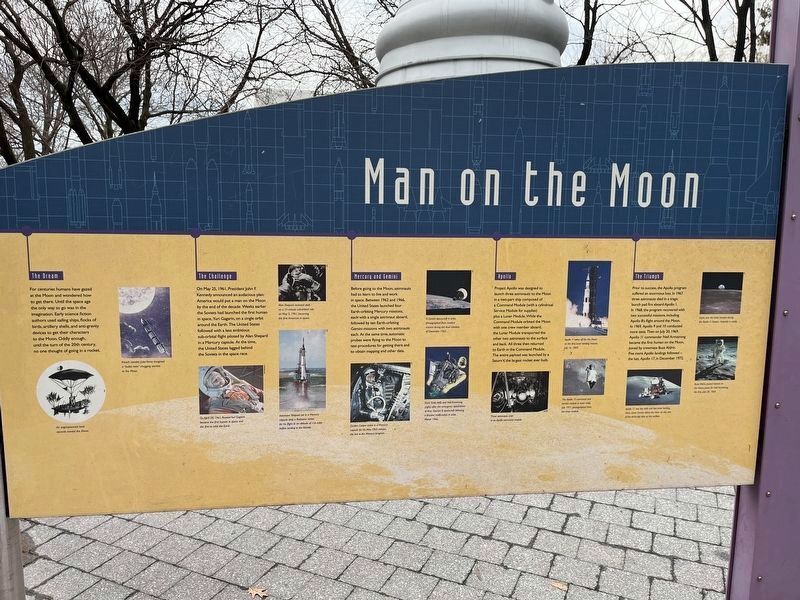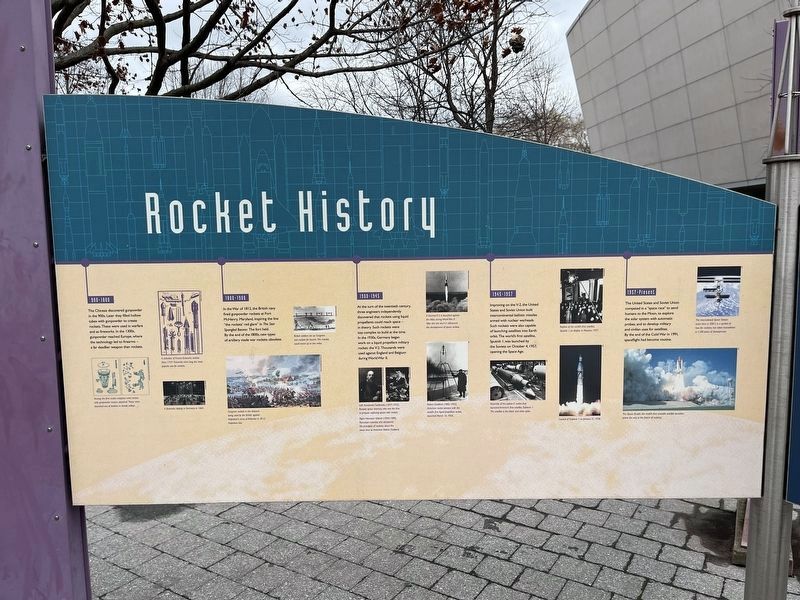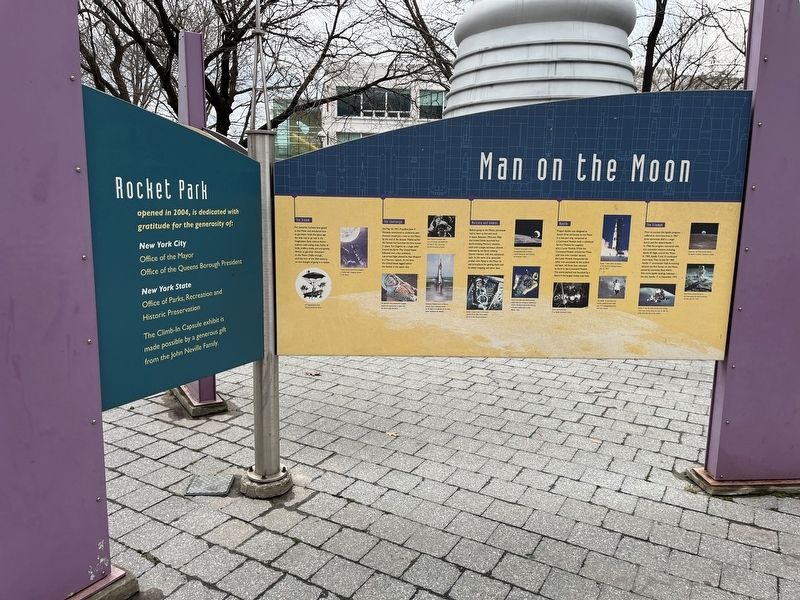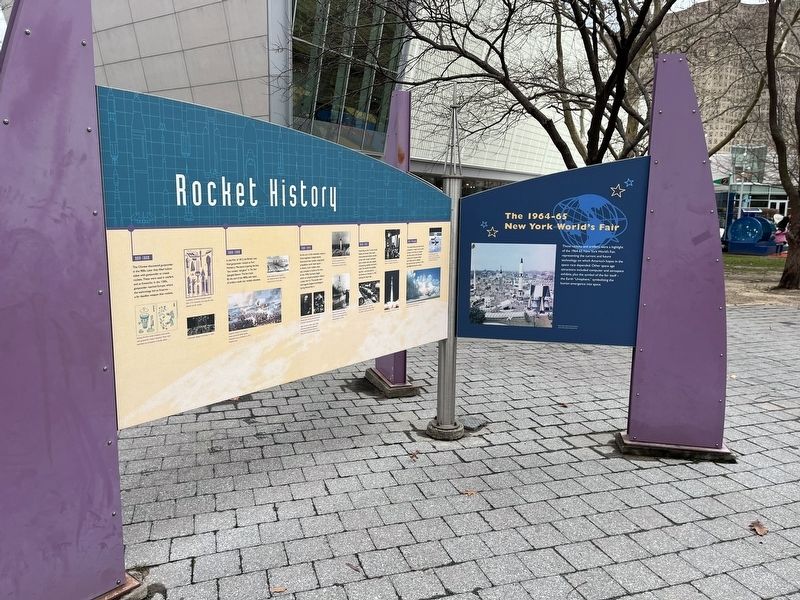Corona in Queens in Queens County, New York — The American Northeast (Mid-Atlantic)
Man on the Moon / Rocket History
The Dream
For centuries humans have gazed at the Moon and wondered how to get there. Until the space age the only way to go was in the imagination. Early science fiction authors used sailing ships, flocks of birds, artillery shells, and anti-gravity devices to get their characters to the Moon. Oddly enough, until the turn of the 20th century, no one thought of going in a rocket.
The Challenge
On May 25, 1961, President John F. Kennedy announced an audacious plan: America would put a man on the Moon by the end of the decade. Weeks earlier the Soviets had launched the first human in space, Yuri Gagarin, on a single orbit around the Earth. The United States followed with a less ambitious sub-orbital flight piloted by Alan Shepard in a Mercury capsule. At the time, the United States lagged behind the Soviets in the space race.
Mercury and Gemini
Before going to the Moon, astronauts had to learn to live and work in space. Between 1962 and 1966, the United States launched four Earth-orbiting Mercury missions, each with a single astronaut aboard, followed by ten Earth-orbiting Gemini missions with two astronauts each. At the same time, automatic probes were flying to the moon to test procedures for getting there at to obtain mapping and other data.
Apollo
Project Apollo was designed to launch three astronauts to the Moon in a two-part ship composed of a Command Module (with a cylindrical Service Module for supplies) plus a Lunar Module orbited the moon with one crew member aboard, the Lunar Module transported the other two astronauts to the surface and back. All three then returned to Earth in the Command Module. The entire payload was launched by a Saturn V, the largest rocket ever built.
The Triumph
Prior to success, the Apollo program suffered an enormous loss. In 1967 three astronauts died in a tragic launch pad fire aboard Apollo 1. In 1968, the program recovered with two successful missions, including Apollo 8's flight around the Moon. In 1969, Apollo 9 and 10 conducted more tests. Then on July 20, 1969, Apollo 11 commander Neil Armstrong became the first human on the Moon, joined by crewmate Buzz Aldrin. Five more Apollo landings followed — the last, Apollo 17, in December 1972.
[Captions:]
An angel-powered boat ascends toward the Moon.
French novelist Jules Verne imagined a "bullet train" chugging tourists to the Moon.
On April 20, 1961, Russian Yuri Gagarin became the first human in space and the first to orbit the Earth.
Alan Shepard rocketed aloft on a 15-minute sub-orbital ride on May 5, 1961,
Astronaut Shepard sat in a Mercury capsule atop a Redstone rocket for his flight to an altitude of 116 miles before landing in the Atlantic.
Gordon Cooper trains in a Mercury capsule for his May 1963 mission, the last in the Mercury program.
A Gemini spacecraft in orbit, photographed from another Gemini during the dual missions of December 1965.
Dave Scott (left) and Neil Armstrong (right) after the emergency splashdown of their Gemini 8 spacecraft following a thruster malfunction in orbit, March 1966.
Three astronauts train in an Apollo command module.
Apollo 11 takes off for the Moon on the first lunar landing mission, July 16, 1969.
The Apollo 15 command and service module in lunar orbit, July 1971, photographed from the lunar module.
Apollo 17 was the sixth and last lunar landing. Here, Gene Cernan dries the rover on day one of the three-day stay on the surface.
Earth over the lunar horizon during the Apollo 11 mission. Australia is visible.
Buzz Aldrin, second human on the Moon, poses for Neil Armstrong, the first July 20, 1969.
900 - 1800
The Chinese discovered gunpowder in the 900s. Later they filled hollow tubes with gunpowder to create
1800 - 1900
In the War of 1812, the British navy fired gunpowder rockets at Fort McHenry, Maryland, inspiring the line "the rockets' red glare" in The Star Spangled Banner. The fort held. By the end of the 1800s, new types of artillery made war rockets obsolete.
1900 - 1945
At the turn of the twentieth century, three engineers independently discovered that rockets using liquid propellants could reach space — in theory. Such rockets were too complex to build at the time. In the 1930s, Germany began work on a liquid propellant military rocket: the V-2. Thousands were used against England and Belgium during World War II.
1945 - 1957
Improving on the V-2, the United States and Soviet Union built intercontinental ballistic missiles armed with nuclear warheads. Such rockets were also capable of launching satellites into Earth orbit. The world's first satellite, Sputnik 1, was launched by the Soviets on October 4, 1957, opening the Space Age.
1957 - Present
The United States and Soviet Union competed in a "space race" to send humans to the Moon, to explore the solar system with automatic probes, and to develop military and civilian
[Captions:]
Among the first rocket weapons were arrows with gunpowder motors attached. These were launched out of baskets in deadly volleys.
A selection of French fireworks rockets from 1747. Fireworks were long the most popular use for rockets.
A fireworks display in Germany in 1665.
British soldiers set up Congreve war rockets for launch. The missiles could travel up to two miles.
Congreve rockets in the distance being used by the British against Napoleon's army at Waterloo in 1815. Napoleon lost.
Left: Konstantin Tsiolkovsky (1857-1935), Russian space visionary, who was the first to propose exploring space with rockets.
Right: Hermann Oberth (1894-1989), Romanian scientist, who discovered the principles of rocketry about the same time as American Robert Goddard.
A German V-2 is launched against the Allies during World War II. After the war the V-2 influenced the development of space rockets.
Robert Goddard (1882-1945), American rocket pioneer, with the world's first liquid propellant rocket, launched March 16, 1926.
Assembly of the Jupiter-C rocket that launched America's first satellite, Explorer 1. The satellite is the black and white spike.
Replica of the world's first satellite, Sputnik 1, on display in Moscow, 1957.
Launch of Explorer 1 on January 31, 1958.
The International Space Station (seen here in 2001) is a symbol of how far rocketry has taken humankind in 1,100 years of development.
The Space Shuttle, the world's first reusable satellite launcher, points the way to the future of rocketry.
Erected 2004 by New York Hall of Science.
Topics. This historical marker is listed in these topic lists: Air & Space • Military • Science & Medicine • War, Cold. A significant historical month for this entry is March 1966.
Location. 40° 44.887′ N, 73° 51.135′ W. Marker is in Queens, New York, in Queens County. It is in Corona. Marker is on Avenue of Science north of 111th Street, on the right when traveling north. The marker stands in Rocket park on the grounds of the New York Hall of Science. Touch for map. Marker is at or near this postal address: 47-01 111th Street, Corona NY 11368, United States of America. Touch for directions.
Other nearby markers. At least 8 other markers are within walking distance of this marker. Rocket Park (here, next to this marker); The 1964-65 New York World's Fair (here, next to this marker); Gemini Titan II (a few steps from this marker); Mercury - Atlas D (a few steps from this marker); Lunar Golf (within shouting distance of this marker); Flushing Meadows Corona Park (about 800 feet away, measured in a direct line); What's Amazing about this Aviary? (approx. 0.2 miles away); Monk Parakeet (approx. 0.2 miles away). Touch for a list and map of all markers in Queens.
Credits. This page was last revised on January 16, 2024. It was originally submitted on January 16, 2024, by Devry Becker Jones of Washington, District of Columbia. This page has been viewed 53 times since then. Photos: 1, 2, 3, 4. submitted on January 16, 2024, by Devry Becker Jones of Washington, District of Columbia.



